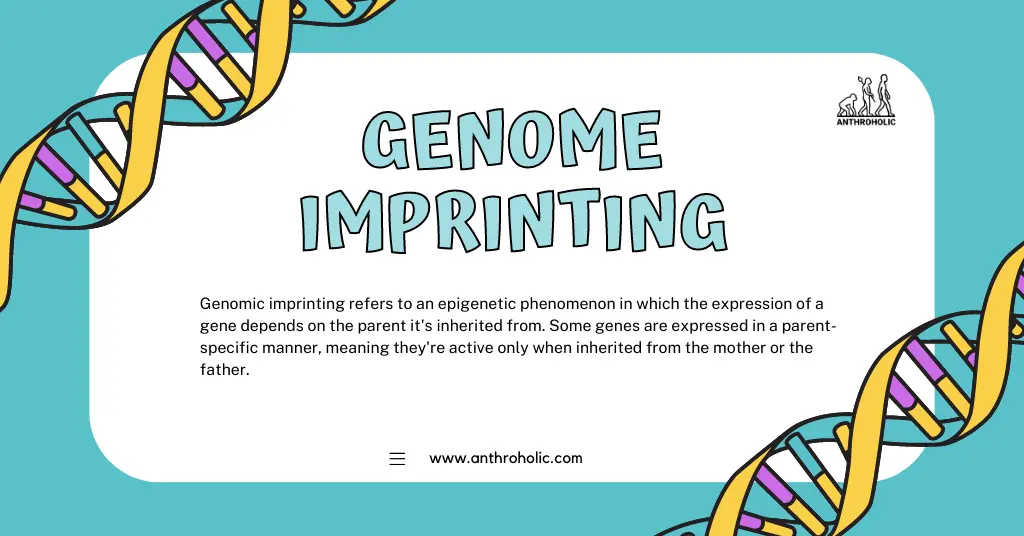AI Answer Evaluation Platform Live Now. Try Free Answer Evaluation Now
Genome Imprinting
Genomic imprinting refers to an epigenetic phenomenon in which the expression of a gene depends on the parent it’s inherited from. Some genes are expressed in a parent-specific manner, meaning they’re active only when inherited from the mother or the father. This pattern of inheritance is fundamentally different from the typical Mendelian inheritance, where the identity of the parent from whom a gene is inherited doesn’t affect its expression [1].

Genomic imprinting plays a critical role in mammalian development, influencing traits such as growth, metabolism, and behavior. Anomalies in imprinting can result in a number of human diseases and developmental disorders, including Prader-Willi syndrome, Angelman syndrome, and Beckwith-Wiedemann syndrome.
Importance of Genomic Imprinting in Anthropology
In anthropology, the study of genomic imprinting provides insights into the evolutionary forces shaping our genomes and the social behaviors they encode. Understanding the patterns of genomic imprinting can offer clues about past mating systems, parental investment strategies, and even human cognitive development [2]. As genomic imprinting influences key aspects of human health and behavior, it is a subject of considerable interest in anthropological genetics.
The Mechanism of Genomic Imprinting
The Role of DNA Methylation
The key mechanism governing genomic imprinting is DNA methylation, a biochemical process that adds a methyl group to the DNA molecule. This modification can affect a gene’s activity without changing its sequence. In mammals, DNA methylation often occurs at cytosine residues, particularly in a context where cytosine is followed by guanine, a region known as CpG sites. When these sites are heavily methylated, the gene is usually silenced.
The establishment of methylation patterns is a complex process occurring during gametogenesis (sperm and egg formation) and early embryonic development. It involves the erasure and re-establishment of methylation marks, allowing for the parent-specific methylation patterns that are characteristic of imprinted genes.
Imprinted Genes and Their Regulation
Imprinted genes are typically organized in clusters, controlled by an imprinting control region (ICR). The ICR is differentially methylated, i.e., it is methylated on one parental allele but not the other. The differential methylation of the ICR governs the parent-of-origin specific expression of the genes within the cluster.
Despite making up a small fraction of the genome, imprinted genes have profound effects on mammalian physiology and behavior. They play important roles in embryonic growth, placental function, postnatal metabolism, and brain function. Given their fundamental roles, alterations in the regulation of imprinted genes can have significant impacts on human health and development.
Genomic Imprinting and Human Evolution
The Evolutionary Origins of Genomic Imprinting
The evolutionary origins of genomic imprinting can be traced to the evolutionary conflict or “battle of the sexes,” an idea known as the kinship or conflict theory. Proposed by David Haig, this theory suggests that imprinted genes evolved due to differential reproductive interests of the maternal and paternal genomes in offspring. The father’s genetic interest is generally in maximizing the growth of each offspring to improve their survival chances, potentially at the mother’s expense. Conversely, the mother’s genetic interest is in allocating resources evenly among all offspring [3].
This conflict-driven view of imprinting can explain why many imprinted genes are associated with fetal growth and maternal resource allocation, demonstrating how genomic imprinting may have shaped our evolution.
Role of Genomic Imprinting in Human Adaptation and Diversification
Imprinted genes have played a significant role in human adaptation and diversification. For instance, the regulation of body size, a trait influenced by imprinted genes, is a key adaptive trait in different environments. Furthermore, some studies suggest that imprinted genes may have contributed to the evolution of the human brain, influencing cognitive functions and social behaviors [4].
Through their roles in shaping such critical traits, imprinted genes have likely contributed to the human species’ ability to adapt to diverse environments and circumstances.
Genomic Imprinting in Health and Disease
Genomic Imprinting and Human Development
Imprinted genes play pivotal roles in human development. They regulate growth in the womb and contribute to the development of different tissues, especially the brain and the placenta. These genes also influence postnatal growth, metabolism, and behavior, which further demonstrates their far-reaching effects.
Diseases Associated with Abnormal Genomic Imprinting
Aberrations in genomic imprinting are associated with numerous human diseases, known as imprinting disorders. These disorders often manifest as developmental and growth abnormalities and can lead to a range of symptoms.
For instance, Prader-Willi syndrome and Angelman syndrome, both neurodevelopmental disorders, result from abnormalities in the same imprinted region on chromosome 15. The specific syndrome that develops depends on whether the abnormality is on the maternally or paternally inherited chromosome. Other disorders like Beckwith-Wiedemann syndrome and Silver-Russell syndrome, which affect growth, are also related to aberrant genomic imprinting.
These disorders illustrate the vital role of genomic imprinting in human health and development and underscore the need for continued research into this unique form of gene regulation.
Ethical and Social Implications of Genomic Imprinting
Ethical Considerations in Genomic Imprinting Research
As with any area of genetic research, genomic imprinting poses various ethical issues. One of the primary concerns revolves around privacy and informed consent, particularly regarding the potential misuse of genomic data. As we continue to unravel the implications of imprinted genes in human health and disease, this information could be used inappropriately, potentially leading to discrimination or stigmatization.
Another ethical concern is the potential for genomic imprinting research to inform prenatal screening or preimplantation genetic diagnosis (PGD). While these techniques could help prevent serious imprinting disorders, they also raise questions about the limits of genetic selection and the potential for eugenics.
Social and Cultural Implications of Genomic Imprinting
The study of genomic imprinting also has profound social and cultural implications. Understanding the influence of imprinted genes on human behavior could reshape our perspectives on various social phenomena, from parental care to social conflict.
However, it’s crucial to approach these issues with caution, as there’s a risk of overinterpreting or misinterpreting the influence of genetics on complex social behaviors. Furthermore, attributing social behaviors to genetic factors could potentially absolve individuals or societies from responsibility for harmful actions or conditions, a phenomenon known as genetic determinism.
Genomic Imprinting in Ancient DNA Studies
Challenges and Opportunities in Studying Imprinting in Ancient DNA
Studying genomic imprinting in ancient DNA presents both unique challenges and exciting opportunities. One major challenge is the quality and quantity of ancient DNA, which can often be degraded or contaminated. Also, detecting imprinting requires information about parental origin, which may be difficult to determine from ancient samples.
Despite these challenges, there’s considerable potential for studying genomic imprinting in ancient DNA. It can provide valuable insights into how imprinting patterns have changed over time or across different human populations, helping to reconstruct past human environments and lifestyles.
Implications of Imprinting Studies on Understanding Human History
The study of genomic imprinting in ancient DNA could significantly enhance our understanding of human history. Imprinting patterns can provide clues about past mating systems, social structures, and even diet, offering a unique window into our ancestors’ lives.
Furthermore, because imprinted genes play vital roles in growth, metabolism, and behavior, they could also shed light on how these traits have evolved in response to changing environments throughout human history.
Future Directions in Genomic Imprinting Research
Emerging Trends in Genomic Imprinting Studies
The field of genomic imprinting is at an exciting juncture with several emerging trends. New sequencing technologies and epigenomic profiling methods are facilitating the discovery of novel imprinted genes and providing deeper insights into the mechanisms underlying imprinting.
There is also increasing interest in the interplay between genomic imprinting and the environment. Studies are examining how environmental factors, such as diet and stress, might influence the regulation of imprinted genes and the potential consequences for health and disease.
Potential Applications of Genomic Imprinting in Anthropology
The study of genomic imprinting holds several potential applications in anthropology. It can enhance our understanding of human evolution and adaptation, revealing how genomic imprinting might have shaped key traits and behaviors.
Moreover, studying imprinting patterns in ancient DNA can provide insights into historical human populations, including their social structures and mating systems. Genomic imprinting research could also inform bioarchaeological studies by shedding light on health and disease in ancient populations.
Conclusion
Recapitulation of Key Points
This review has explored the fascinating field of genomic imprinting and its relevance to anthropology. We’ve discussed the mechanism of genomic imprinting, its role in human evolution and health, and the ethical and social implications of imprinting research. We also considered the challenges and opportunities of studying imprinting in ancient DNA and looked ahead to future directions in the field.
Prospects for Future Research in Genomic Imprinting in Anthropology
As genomic technologies continue to evolve and our understanding of imprinting deepens, the coming years will likely bring further insights into the significance of genomic imprinting for anthropology. It holds promise for enriching our understanding of human biology, evolution, and culture, and offers exciting opportunities for interdisciplinary research.
References
[1] Ferguson-Smith, A. C. (2011). Genomic imprinting: the emergence of an epigenetic paradigm. Nature Reviews Genetics, 12(8), 565–575.
[2] Haig, D. (2013). Kin conflict in seed development: an interdependent but fractious collective. Annual Review of Cell and Developmental Biology, 29, 189–211. https://www.researchgate.net/publication/236635914_Kin_Conflict_in_Seed_Development_An_Interdependent_but_Fractious_Collective
[3] Haig, D. (2000). The kinship theory of genomic imprinting. Annual Review of Ecology and Systematics, 31(1), 9–32.
[4] Crespi, B., & Badcock, C. (2008). Psychosis and autism as diametrical disorders of the social brain. Behavioral and Brain Sciences, 31(3), 241–261.




